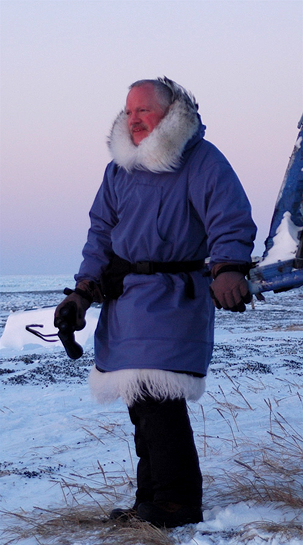The evening mist was darkening and I knew there may only be another hour of gray light in the forest. I was walking past the workshop of a totem pole carver that sat at the trailhead in Klawock, on Prince of Wales Island. On the gravel surrounding it laid a dozen old, critically cracked poles, copies made during the CCC days of the Great Depression of still older totem poles. There were bears, eagles, ravens, a wolf, a frog and other mysterious animals that had been carefully carved out and painted on the tall cedar poles. They were lying so respectfully, I thought, face-up and wide-eyed in several neat rows.
Stepping over a log I saw ferns, pinecones and branches littering the wet floor of the forest. Mossy barked trees, young, old and some dead, stood quietly in the damp dusk. The twisting trail was filled with slippery roots and pools of mud. The river was a short distance and standing on the bank I could see several bald eagles, tens of seagulls and several ducks all taking flight as I emerged from the forest. The smell of death came from decomposing bodies of salmon littering the bank where they had jumped out of the clear, turbulent waters and died. Their white bony bodies numbered in the hundreds, I figured, just in that one stretch of waterway.
Hiking the trail along the bank I crossed several small wooden bridges covering streams that flowed into the bird-filled river. Some of the older bridges were merely decaying split logs. The long green hair-like moss hung everywhere in the dripping, darkening forest. Looking around, I thought there must be hundreds of forms of fungus, of various colors, from large to small, growing on wood and ground.
Such a rich landscape had so much to give people. Fresh water, wood and meat were plentiful and I felt the spirits must be proud of what they have done here.
Then I remembered seeing the totem poles by the carver's workshop and wondered how each animal or being carved represented a relationship a family had with that creature. In such a diverse environment I could see the people having a strong working connection to a number of plants and animals, each contributing to the wealth of their way of life. It was man's relationship with the dog that initially developed civilization; later came corn, chickens, salmon, oil and trees, etc. The spirits of nature are great providers and teachers and they have enabled people to build a rich and resourceful community and culture. The children should learn how to build a practical and meaningful connection to the diversity of their own environment, especially with Elders, so they can remain reassured, resilient and not feel lost in tough times.
Seeing the moist moss covered firs in the forest, at home beside the river, I thought of how a single tree can contain a multitude of spirits that can teach and enrich our lives, much like our Elders. The spirits of totems will stay even if the landscape has been forsaken. They will stay so someday things can learn how to return to normal; nature has a way of rediscovering and rebuilding itself. The eagles will comeback to roost, the salmon will find their place of birth and the wolves will remember their old hunting grounds. Man will have to find his lost love of things wild to return home, because the truth is when the past re-emerges, ghost-like back into the present. Man will have to find his lost totems and forgotten teachers; all those spiritual connections to his place of birth and natural community. Like a dogged child, he will have to learn how to listen well to those beings greater than himself.
The night had just arrived when I returned to the carver's workshop and saw once again the old totem poles lying face-up on the moist ground, dimly illuminated by a distant streetlight. I felt like they were staring out into the rainy night, watching and waiting for the lost souls of the windy forest to return to their ancient homes.

